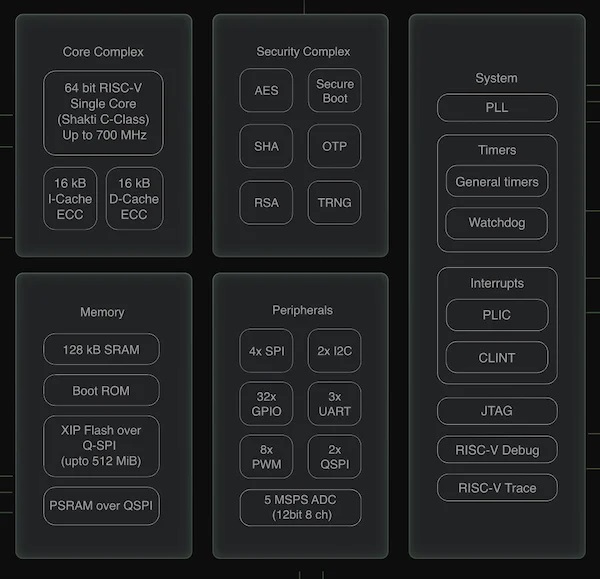Mindgrove Brings First Indigenously-Designed RISC-V MCU to India
The new RISC-V-based SoC is the first microprocessor owned, designed, and marketed entirely from India to the open market.
While semiconductor technology is a matter of national security for almost every nation, chip manufacturing is still localized to a handful of countries. The U.S. International Trade Administration found that India imports 95% of its semiconductors from China, Taiwan, South Korea, and Singapore. This makes India and many other regions almost wholly reliant on other countries for its technological backbone.

The RISC-V-based Secure IoT MCU.
To strengthen India's domestic chip foothold, startup Mindgrove has released Secure IoT, the world’s first Indian-designed and commercialized high-performance MCU.
Secure IoT: A 700-MHz, High-Performance MCU
The Secure IoT microcontroller integrates several complex units designed to ensure high performance, robust security, and versatile functionality for various IoT applications. The microcontroller is centered around a Shakti C-Class processor, a 64-bit RISC-V single-core processor capable of speeds up to 700 MHz. This processor is characterized by its efficiency and power in processing complex computations. As a testament to this, Secure IoT maintains a peak power consumption of under 200 mW.
The core complex includes a 16 KB instruction cache and a 16 KB data cache, both equipped with error-correcting code (ECC) to prevent data corruption. The device's memory configuration also includes 128 KB of static RAM, boot read-only memory (ROM), and options for expandable storage through execute-in-place (XIP) Flash over Quad SPI, supporting up to 512 MB, as well as PSRAM over QSPI.

Block diagram of the Secure IoT.
The Secure IoT microcontroller is fortified with dedicated cryptographic modules, including AES, SHA, and RSA, a secure boot mechanism, a true random number generator (TRNG), and one-time programmable (OTP) memory. These features work in tandem to effectively safeguard against various attacks and unauthorized access.
The Secure IoT microcontroller is equipped with a comprehensive set of system management components. These include a phase-locked loop (PLL), general timers, a watchdog timer for system recovery, and a configurable interrupt controller (PLIC) to manage multiple interrupt sources alongside a Core Local Interruptor (CLINT) for timer and software interrupts. Peripheral support is extensive, featuring multiple serial protocol interfaces such as four SPI, two I2C, and three UART channels, along with 32 general-purpose I/O pins and specialized peripherals like pulse-width modulators (PWM) and a high-resolution analog-to-digital converter (ADC) capable of 5 MSPS.
A Milestone for Indian Semiconductors
Secure IoT marks a significant milestone in the semiconductor industry, particularly in India's growing technological sovereignty and economic strategy. As India’s first commercial high-performance microcontroller, the chip demonstrates a shift away from reliance on international suppliers. In an era where global supply chains are often vulnerable to geopolitical tensions and trade disputes, having domestic capabilities in critical technologies like semiconductors enhances national security and resilience.
The Secure IoT SoC also allows Indian OEMs to cut costs by about 30% compared to international counterparts while maintaining, or even enhancing, the functionality and performance of their products. This cost efficiency opens up new opportunities for local businesses and startups to innovate within the IoT space without the financial burden of expensive chip imports.
Mindgrove can break these financial barriers because it bases Secure IoT upon the RISC-V architecture. RISC-V’s open-standard instruction set architecture (ISA) reduces licensing costs and barriers to innovation compared to proprietary alternatives.
Leveraging the Benefits of RISC-V
The Secure IoT SoC represents both a technological advancement and a critical socio-economic and political tool for India. RISC-V's flexibility and accessibility have enabled Mindgrove Technologies to tailor the SoC to specific market needs and security requirements without the constraints typically imposed by ISA royalties and restrictions.


.jpg)
